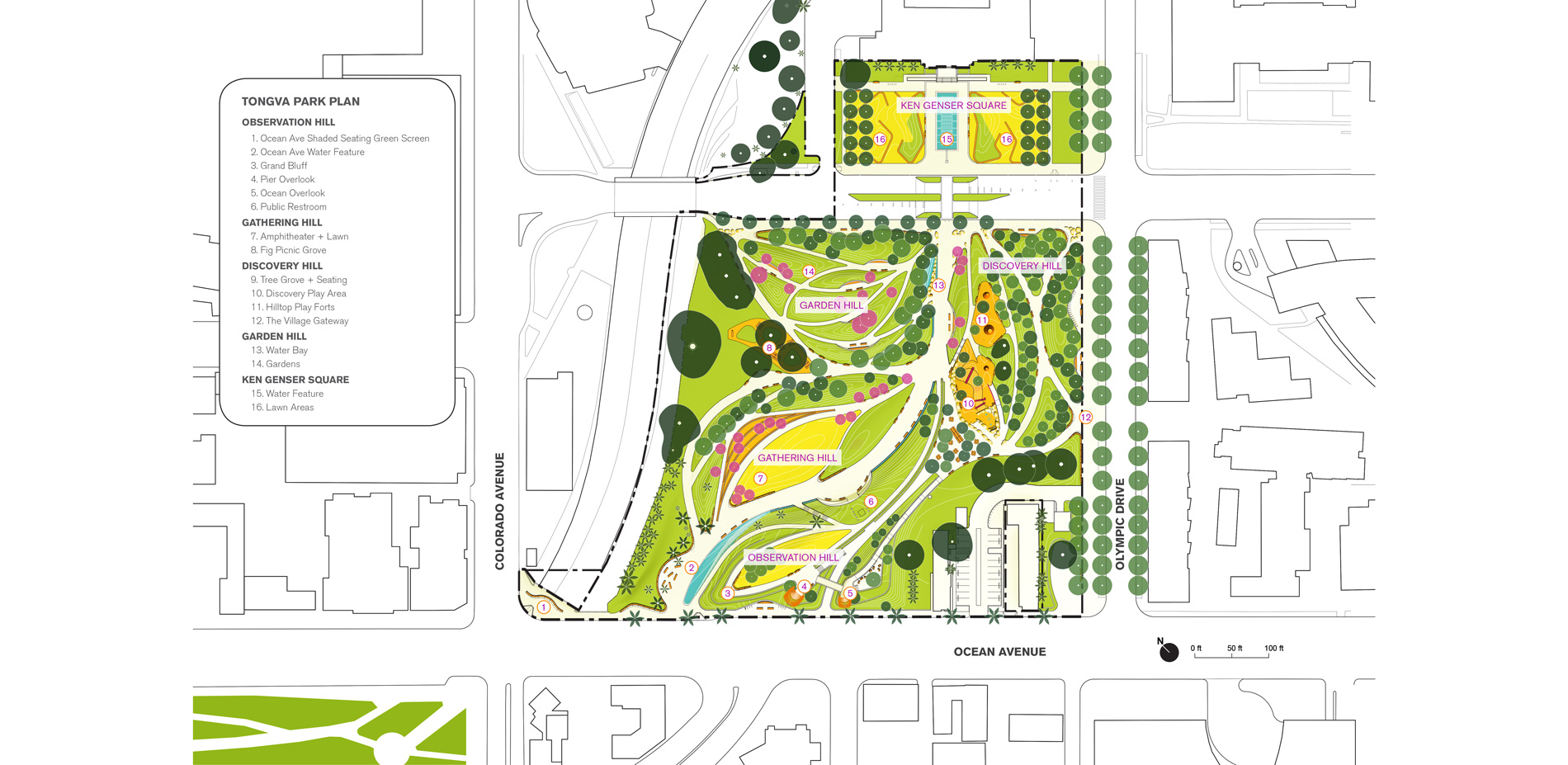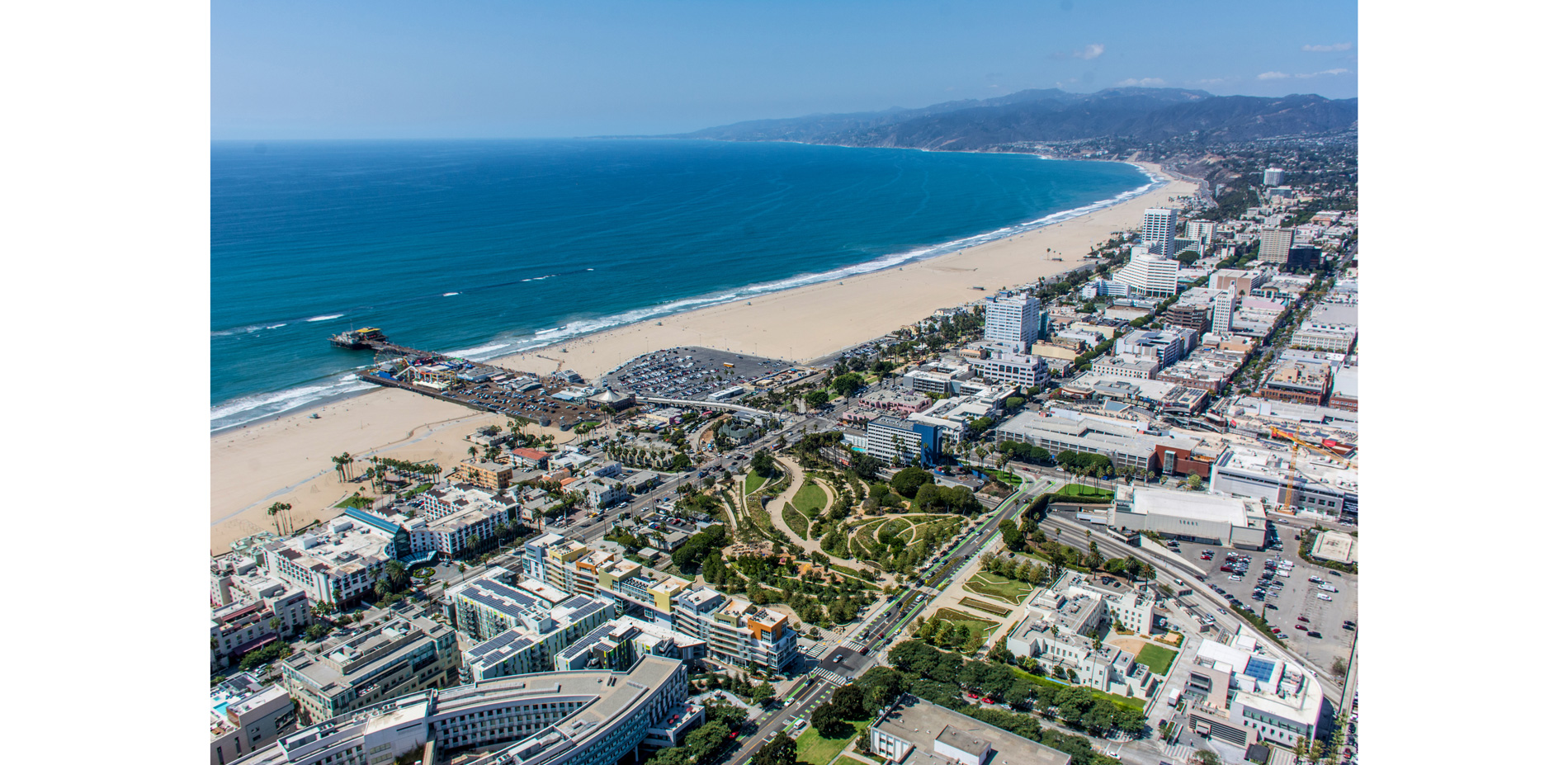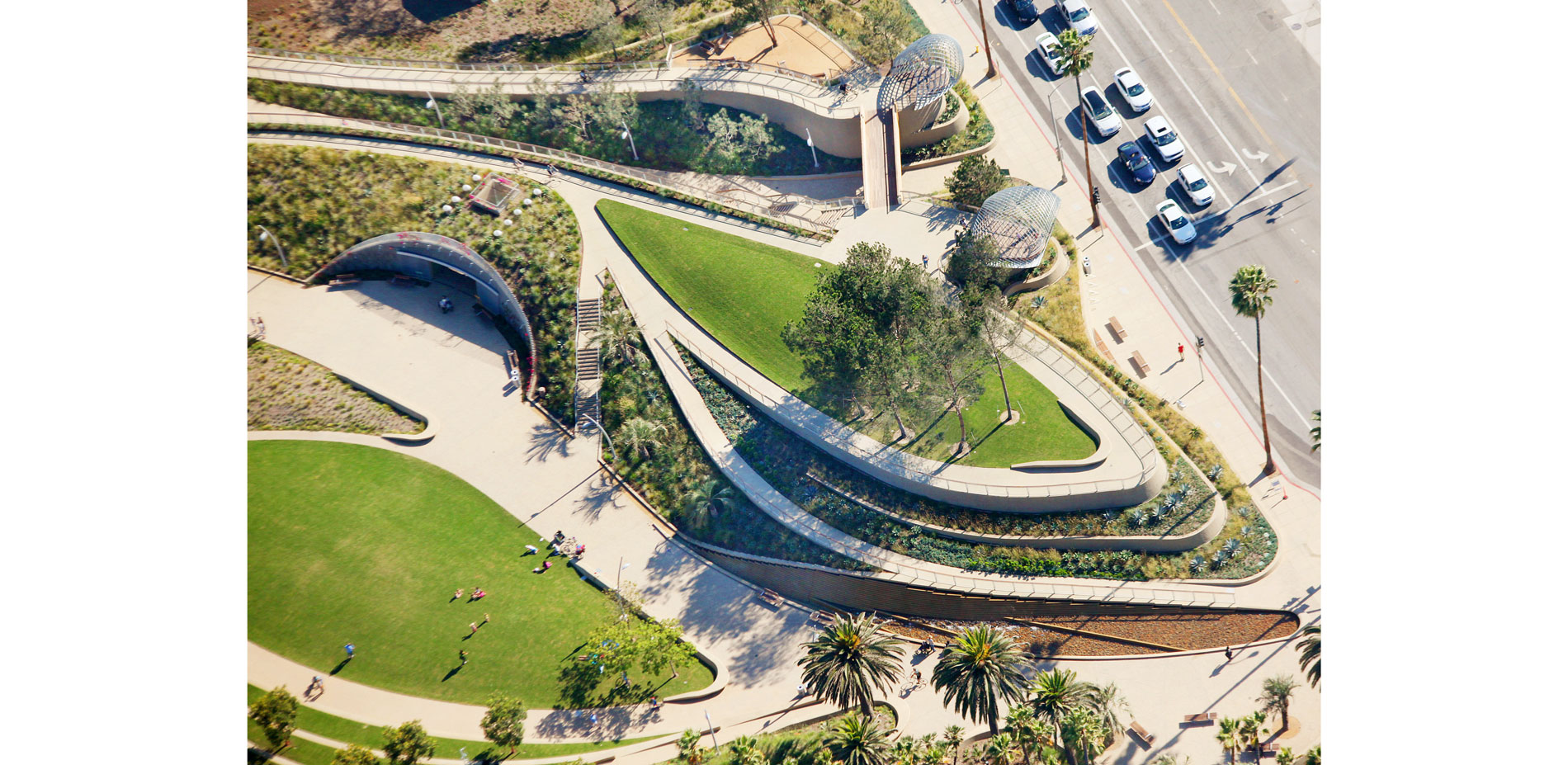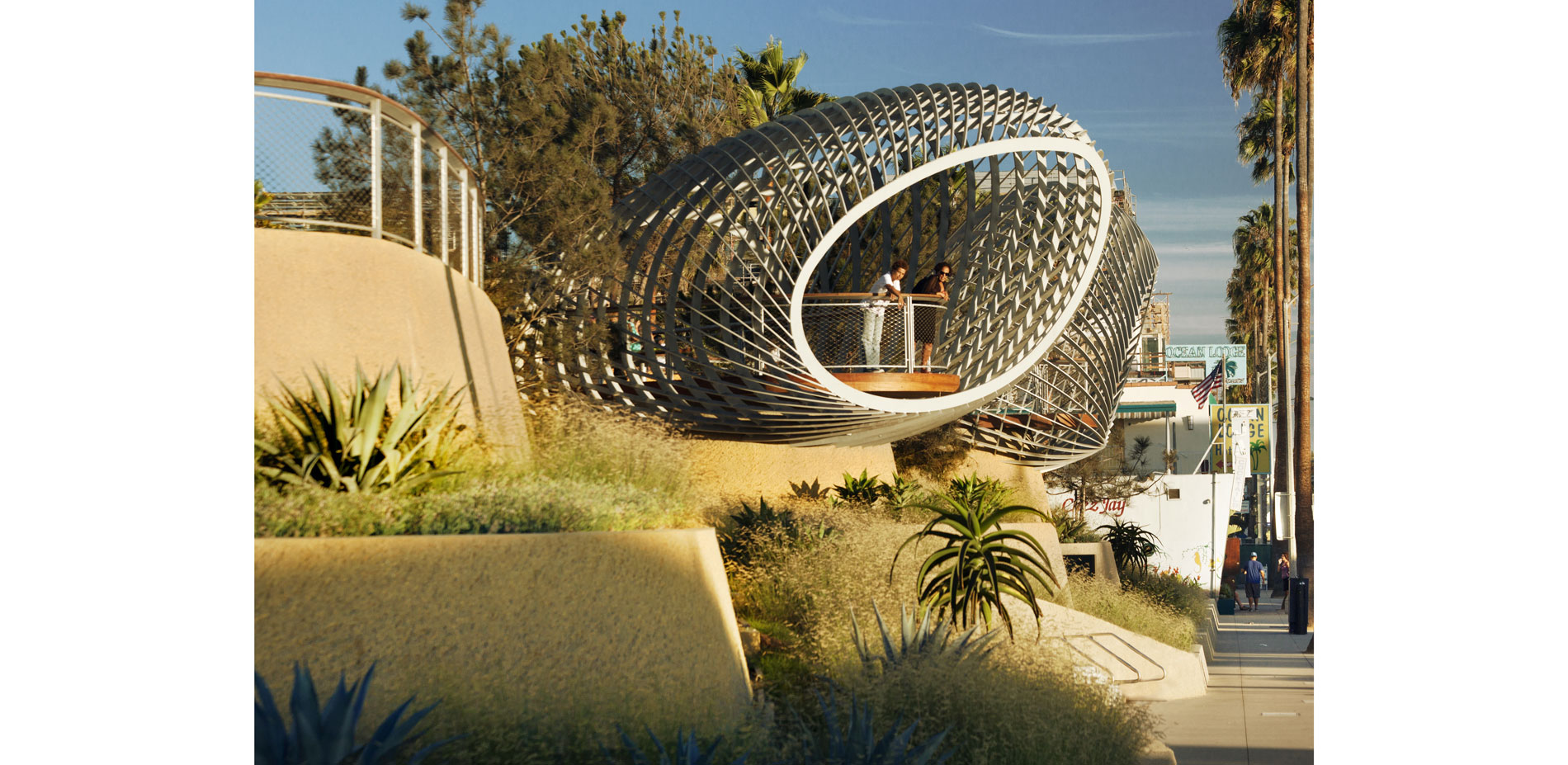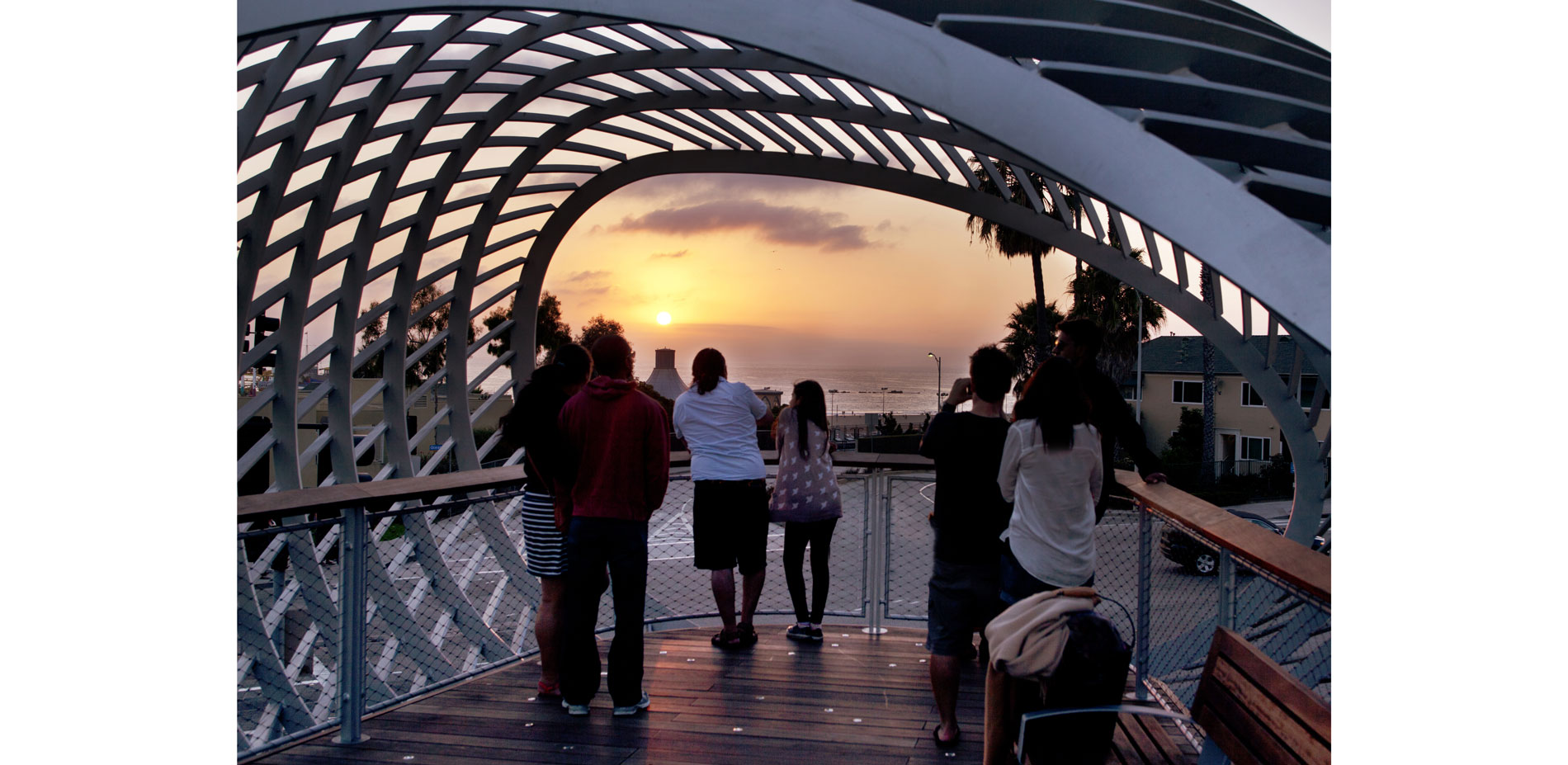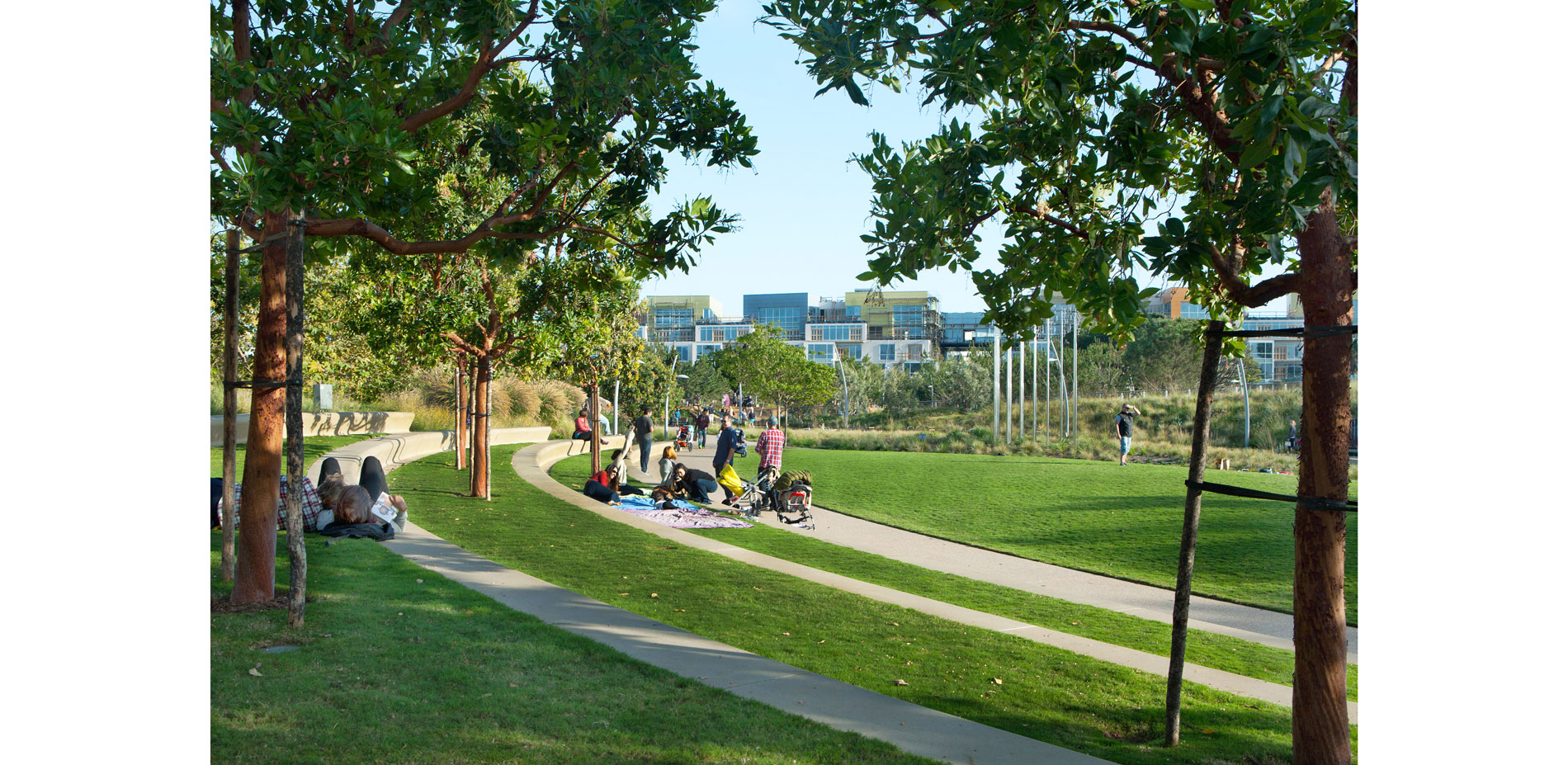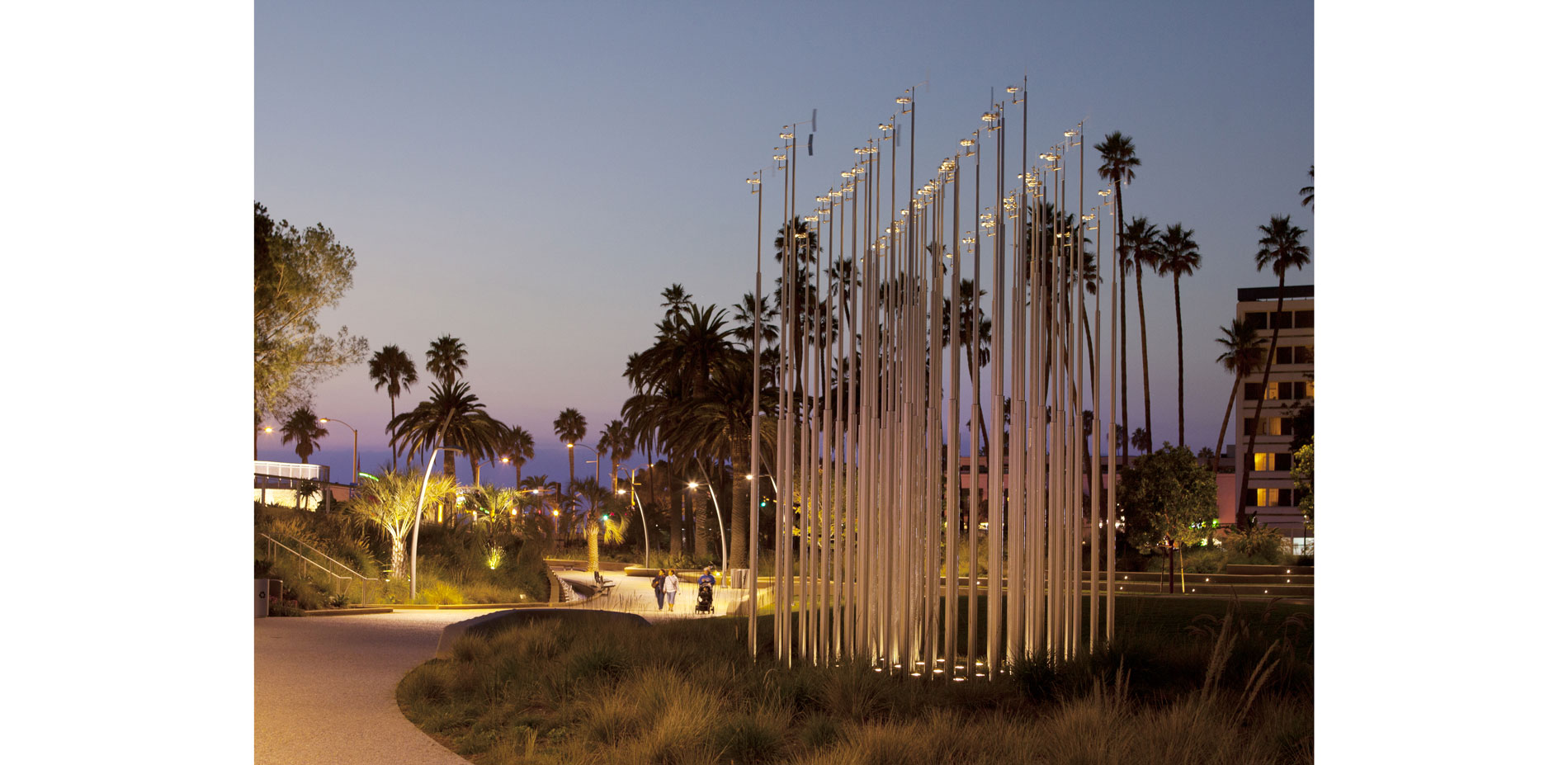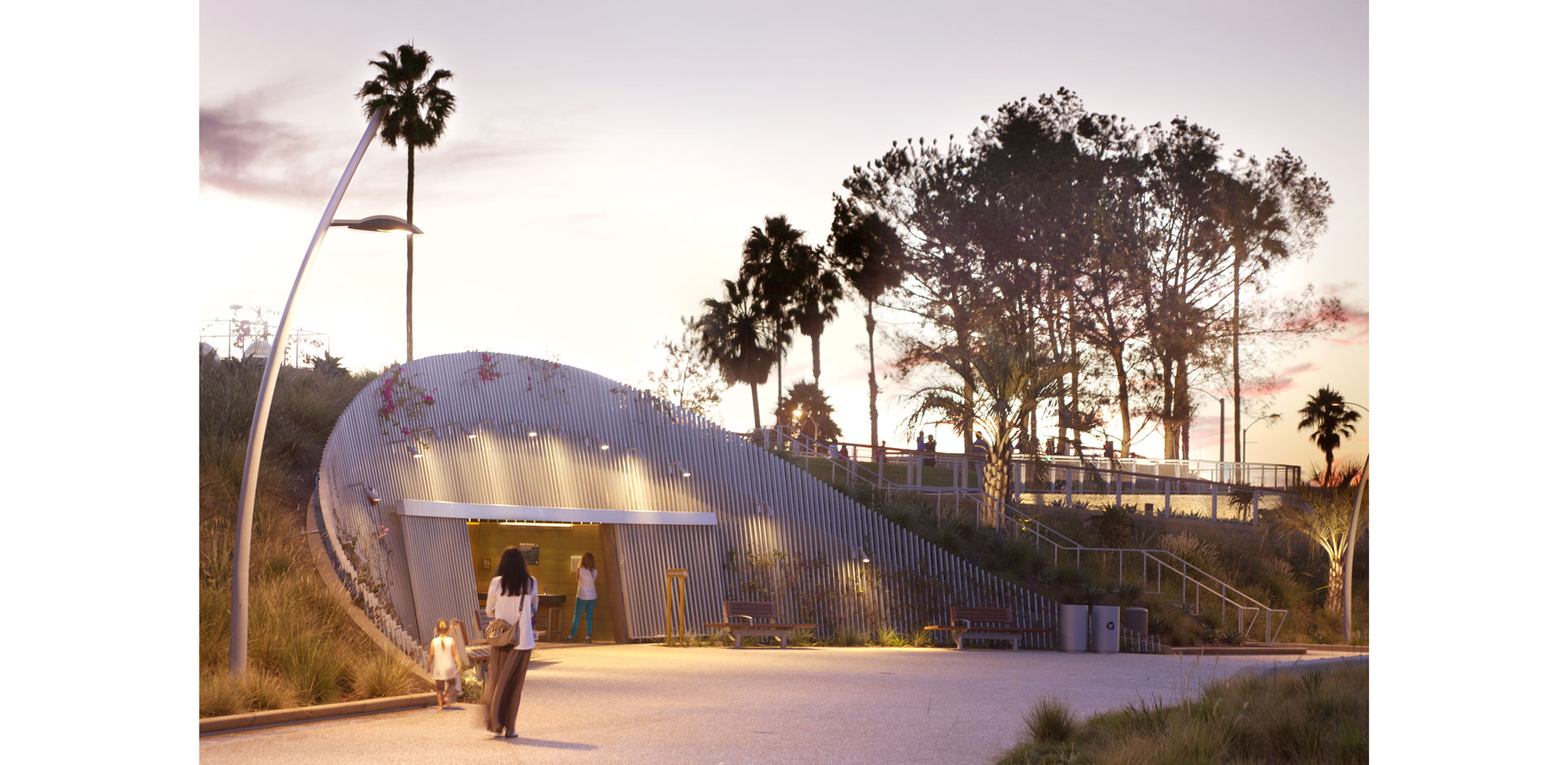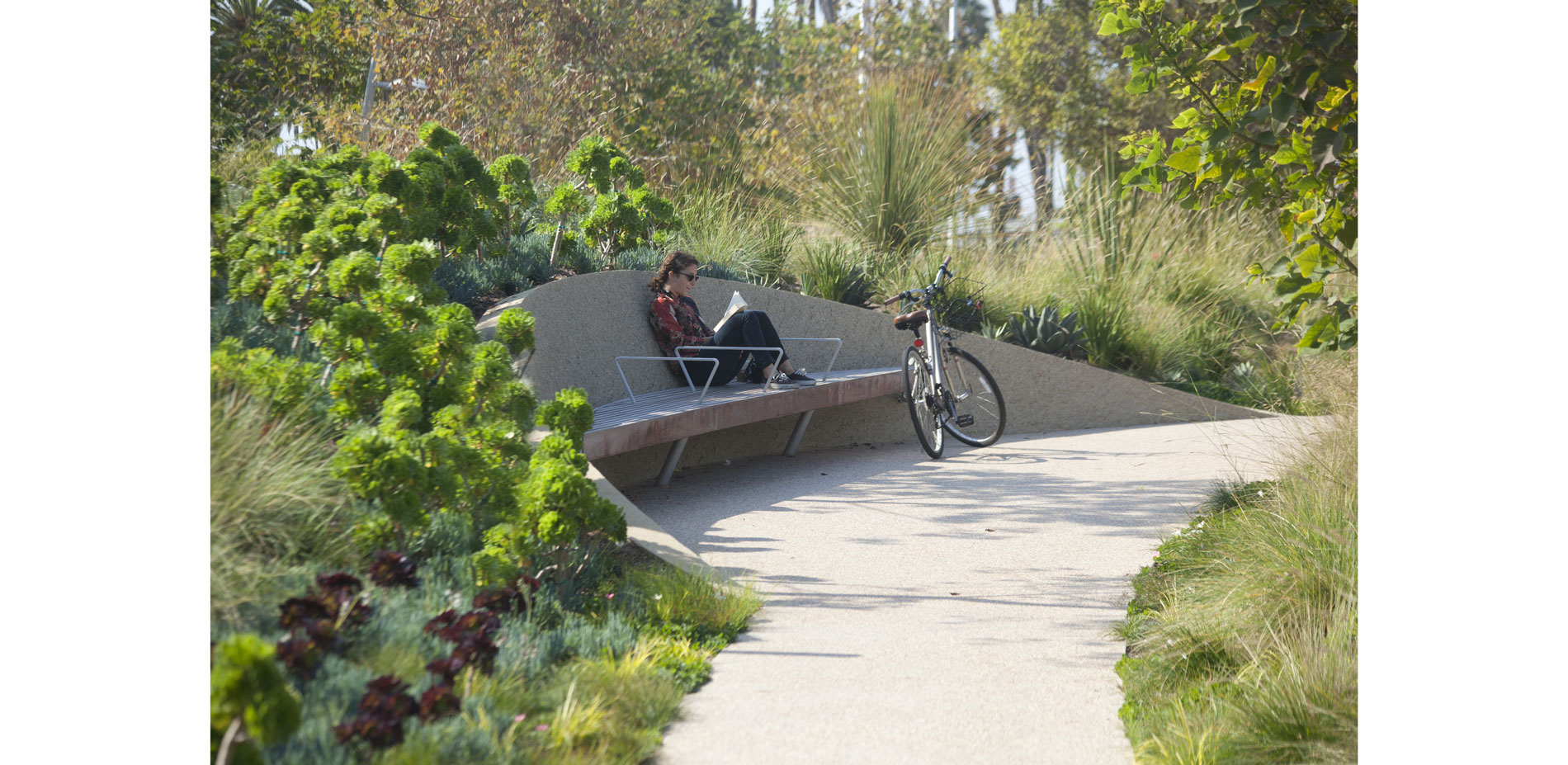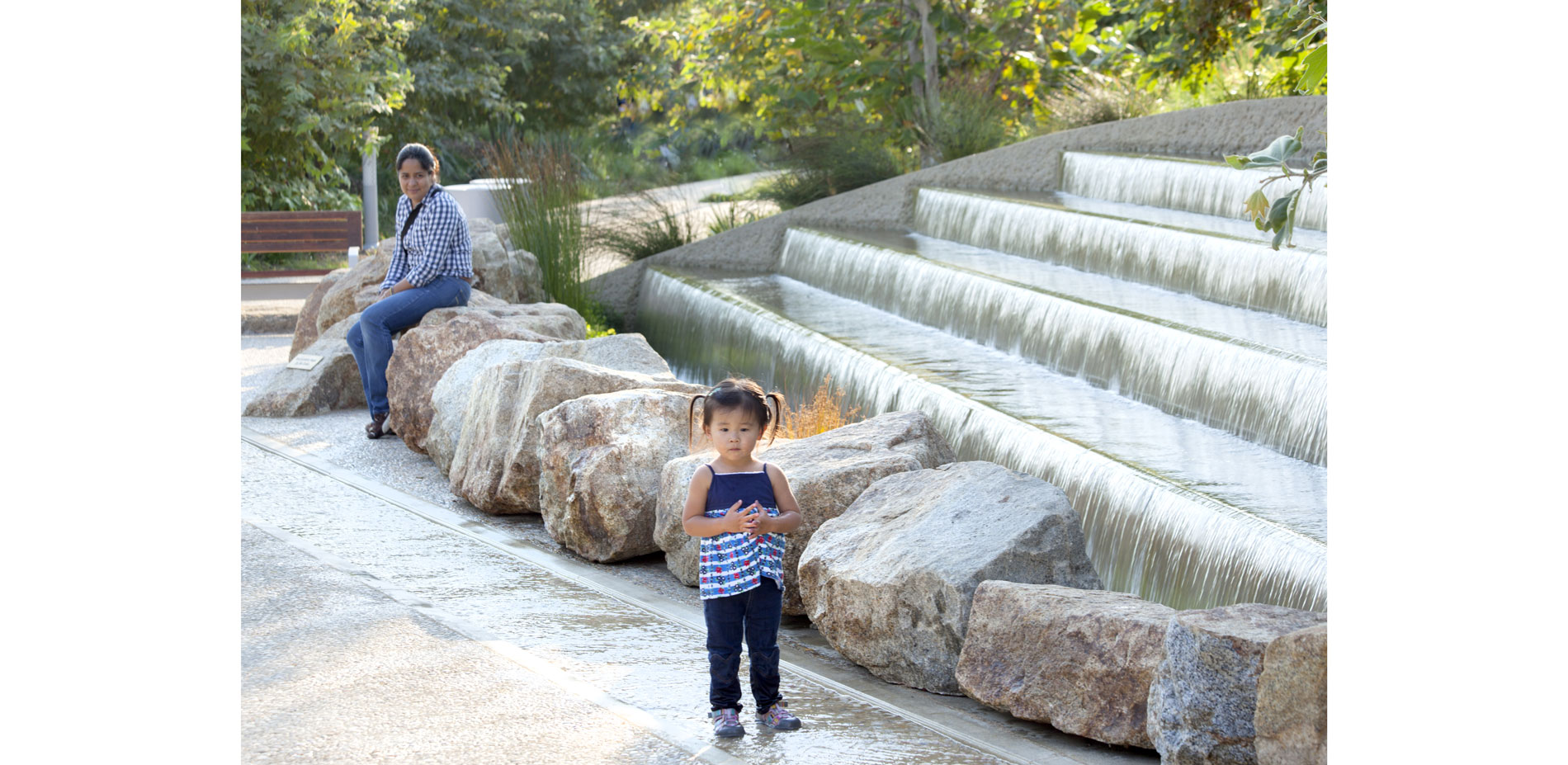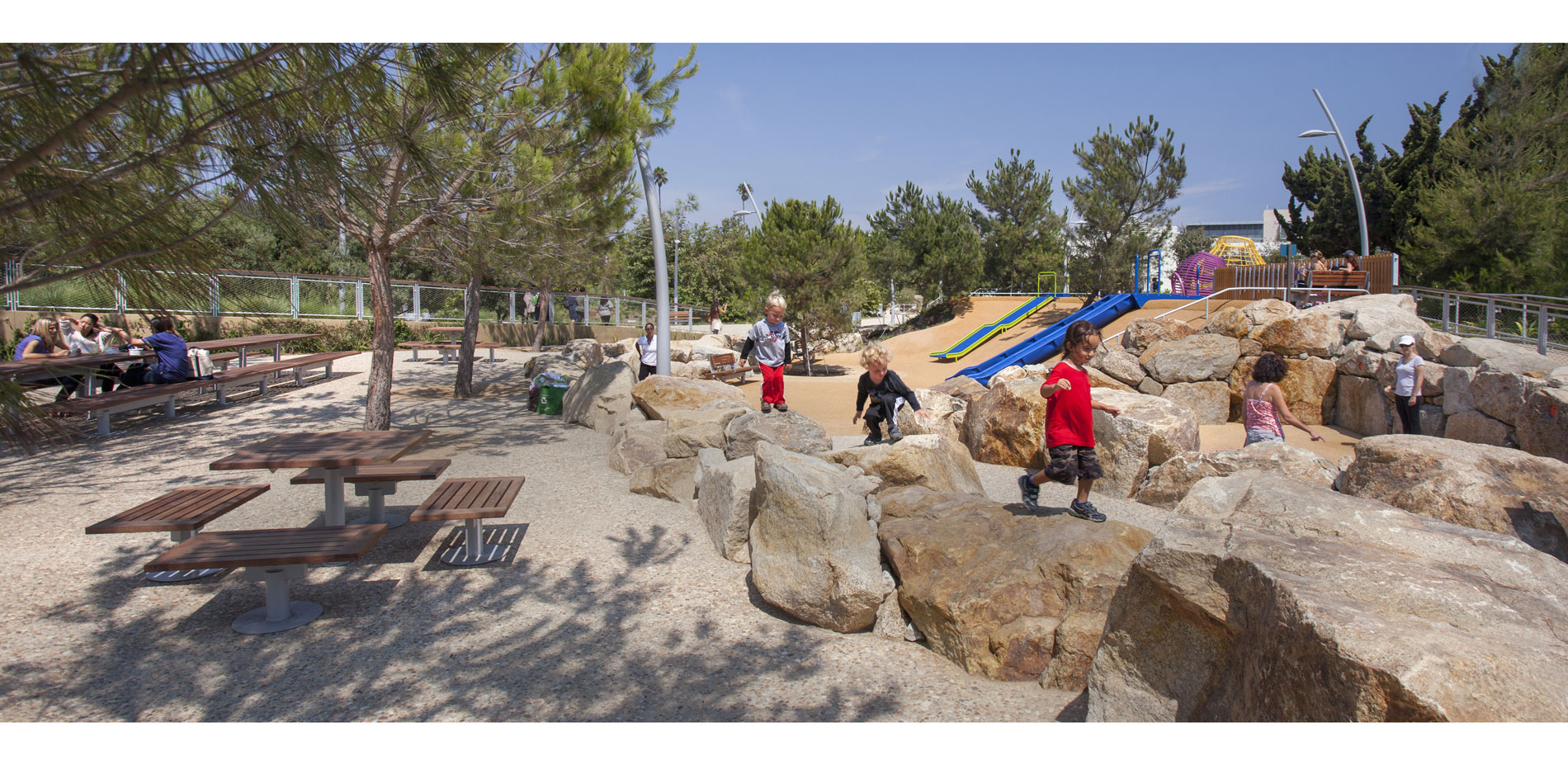Tongva Park and Ken Genser Square
HONOR AWARD
General Design
Santa Monica, CA, USA | James Corner Field Operations LLC | Client: City of Santa Monica
It’s like an oasis. Refreshing.
- 2018 Awards Jury
PROJECT CREDITS
Lead Designer
- James Corner Field Operations
Additional Project Credits
- Landscape Architect: James Corner Field Operations
- Principal-in-Charge: James Corner, ASLA
- Project Team: Lisa Tziona Switkin, Sarah Weidner Astheimer, Matt Grunbaum, David Christensen, Tsutomu Bessho, Yitian Wang
- Contractor: W.E. O'Neil
- Architecture for Restroom: Frederick Fisher & Partners
- Structural & MEP Engineering: Buro Happold
- Civil Engineering: Fuscoe Engineering
- Lighting Design: HLB
- Water Feature Design: Fluidity Design Consultants
- Horticulture: Perry & Associates
- Horticulture: Greenlee & Associates
- Irrigation: d.d. Pagano, Inc.
- Urban Soils: Wallace Labs
- Geotechnical Engineer: Converse Consultants
- Artist: Iñigo Manglano-Ovalle
PROJECT STATEMENT
Tongva Park + Ken Genser Square transformed a former parking lot into a lush landscape of rolling hills, meadows and gardens. The design was shaped by an extensive community process and is now celebrated as an important destination and center for Santa Monica. The most dramatic aspect of the site transformation has been the restoration of its ecosystem - new forest types and amended soils respond to the design's microclimates and showcase a diversity of species specifically suited to each area. Over three hundred carefully selected new trees, thousands of new plants, and hundreds of California native and appropriately adapted species are part of the ambitious planting scheme. As such, it is one of the first large-scale contemporary urban projects to highlight California native plants as significant horticultural features, and was a trailblazer for climate-appropriate water use in the public realm. The project's sustainability is boldly evident not only in its ecology and use of water, but also in its diverse social use and vibrancy, as its varied and flexible spaces attract users of all backgrounds.
PROJECT NARRATIVE
Project Overview
Situated on 7.4 acres between City Hall, the Interstate-10 freeway, and Santa Monica's iconic palm tree lined Ocean Avenue, Tongva Park + Ken Genser Square have transformed a derelict and flat parking lot into lush landscape of rolling hills, swales, Mediterranean meadow gardens, and active urban spaces.
Vision
Santa Monica is a city that uses its parks and open spaces intensely, and whose identity and character is strongly associated with the openness of the ocean and the rugged landscape of the mountains to the north. Its open spaces are an essential feature of the community and make it one of the most desirable places to live in the region. For this reason, the city has taken a pro-active approach to expanding its park and open space resources, focusing on lands already in public ownership and in locations where their value to the community can best be leveraged. Through this effort, the Civic Center area emerged as the city's focus to recycle underutilized land and create an open space to foster stronger connections to surrounding neighborhoods.
The design brief for this project was 'to construct a park and "garden walk" that reflected the identity of the city and created a destination and gathering place of great social, ecological, and symbolic value.' Shaped by extensive community participation, the design of this project creates a contemporary, sustainable, and transformative urban landscape that redefines the center of Santa Monica, establishes a system of linked central parks, re-knits the city fabric through strong linkages to Downtown, the adjacent neighborhoods, the Santa Monica State Beach, Palisades Park, and the Main Street commercial area, and mitigates the barrier created by the Santa Monica Freeway.
Design Excellence and Sustainability
Design and sustainability come together in this project to produce a new type of urban landscape that is active, innovative, resource-conscious, and ecologically rich. The sustainability of the parks can be measured not only in terms of ecology, water, energy, and materials; but also in terms of social vibrancy as places that promote the health and wellbeing of the people who experience them.
Inspired by the Southern California arroyo landscape of washes and ravines that once defined the site, a series of braided pathways appear to organically emerge from the footsteps of City Hall, extend west to Ocean Avenue, and weave the park into the fabric of the City. Architectural features, water features, a texturally rich material palette, and lushly planted meadows and gardens reinforce the site's "arroyo" history, while at the same time, creating an exciting new identity that is unique to Santa Monica. Dramatic rising and falling topography reinforces the fluid pathway system and organizes the site into four thematic hilltop areas, each calibrated to a different primary use and experience:
- Garden Hill is defined by a series of seating alcoves and intimate display gardens that showcase seasonally dynamic, native, and appropriately adapted Southern California plants;
- Discovery Hill is a play space for children, offering a range of discovery experiences and settings with hill slides, a music wall, water play, and custom play structures embedded into a lush and shaded landscape;
- Observation Hill offers the best views of the ocean and neighboring vicinity culminating in two distinctive shell-like overlooks that frame iconic views and vistas of Santa Monica and the ocean;
- Gathering Hill provides open space for people to come together, recreate, and gather on a large multi-purpose lawn with seating terraces and an informal picnic area;
- Ken Genser Square provides new space for civic gatherings and complements the City Hall landmark building with its symmetrical footprint, low pre-cast seat walls, and gently rolling grassy hills.
Ecology
The most dramatic aspect of the site transformation has been the restoration of the ecosystem. The project has been fundamentally modeled on healthy, native environments whose interconnected botanical, hydrologic, and topographic systems work to provide restored ecosystem services to the site.
New forest types and amended soils respond to microclimates and showcase a diversity of species suited to different parts of the project. Over three hundred carefully selected new trees, thousands of new plants, and hundreds of different Southern California native and appropriately adapted species are part of the project's abundant and ambitious planting scheme. As such, it is one of the first large-scale contemporary urban projects to highlight Southern California native plants as significant horticultural features.
Existing trees were preserved and form an important backbone for new plant material. "Morty," a large Moreton Bay Fig tree, was fondly named by Santa Monica residents and now hosts a picnic grove near its impressive canopy. "The Three Amigos," three mature Ficus trees, were successfully relocated close by to create a "Fig Grove" that dramatically buffers the freeway, while existing palms are clustered close to the park's main entry to provide vertical structure along the park's edge.
New trees are grouped into three forest types, which are modeled on native California Coastal Scrub, Chaparral, and Riparian plant communities. They are carefully positioned to take advantage of the site's numerous microclimates, provide the framework for the project's extensive plant palette, and contribute to the distinctiveness of spaces within the park. Discovery Hill hosts more trees than any other part of the park. It combines silvery olives and oaks for maximum shade. Groves of pines can be found nearby at Observation Hill. Its terraced western edge faces south to some of the toughest site conditions and features Blond Ambition Grass interlaced with cascading succulents, aloes, and agave. Western Sycamores weave their way between the hills at swales and low points to frame a soft meadow interior that features grasses, wild flowers, and Mediterranean bulbs. Appropriately adapted specimen trees selected for their flower or distinctive form increase the diversity of species within the park and are located within Garden Hill and along the park's central path.
Sustainability + Collaboration
The project offers a new model of sustainability for similarly scaled projects-- one that carefully balances environmental and cultural considerations. The radical restoration of ecosystem services to the site via amended soils and a dramatic biomass increase is complemented by an irrigation system that uses water from the nearby Santa Monica Urban Runoff Recycling Facility. Irrigated water and stormwater are maintained on site through the natural movement of water into bioswales at the base of most hills in the park.
Areas of the project which are not planted contribute to the social sustainability of the project, which is uniquely high. Developed in close collaboration with the city and community, the park's range of social spaces include areas for quiet contemplation, a large community gathering space, and inclusive play area for all ages and abilities. The project specifically promotes human health through a series of walking trails and loops, and bike parking areas, which are promoted on the park's website.
The project's successful realization and sustainable strength is directly related to the incredibly collaboration of the project team, which included the city, community, landscape architect, interdisciplinary team of professional sub-consultants, and design-build contractor.
PRODUCTS
Product Sources: HARDSCAPE
- Concrete flatwork with custom exposed aggregate finish. Concrete supplied by Catalina Concrete, installed and finished by Shaw and Sons.
Product Sources: LIGHTING
- BK Lighting, Valmont, Boca Flasher.
Product Sources: FURNITURE
- Majority custom designed with freestanding benches from Landscape Forms.
Product Sources: DRAINAGE
- EX Flow drain pipe, NDS drainage inlets, Maxwell Plus Dry Well.
Product Sources: FENCE/GATES
- Concrete shotcrete walls with custom exposed aggregate finish. Concrete supplied by Catalina Concrete, installed and finished by Shaw and Sons.
Product Sources: IRRIGATION
- Rain Bird
Product Sources: LUMBER/DECKING
- Jarrah hardwood. Alaskan Cedar Glullam beams for the bridge.
Product Sources: PARKS RECREATION
- Landscape Structures custom slides.
Product Sources: STRUCTURES
- Custom fabricated steel structures with high performance Tnemec paint finish (3x play structures, Overlooks, Green Screen, guard and hand rails)
Product Sources: OTHER
- PLANTSSan Marcos Growers, Sun Crest Nursery, Valley Crest Nursery (Fillmore), Berylwood Tree Farm, Norman's Nursery, Instant Jungle, El Nativoa
